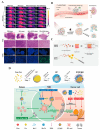The Role of Inorganic Nanomaterials in Overcoming Challenges in Colorectal Cancer Diagnosis and Therapy
- PMID: 40284405
- PMCID: PMC12030334
- DOI: 10.3390/pharmaceutics17040409
The Role of Inorganic Nanomaterials in Overcoming Challenges in Colorectal Cancer Diagnosis and Therapy
Abstract
Colorectal cancer poses a significant threat to human health due to its high aggressiveness and poor prognosis. Key factors impacting patient outcomes include post-surgical recurrence, chemotherapeutic drug resistance, and insensitivity to immunotherapy. Consequently, early diagnosis and the development of effective targeted therapies are essential for improving prevention and treatment strategies. Inorganic nanomaterials have gained prominence in the diagnosis and treatment of colorectal cancer owing to their unique size, advantageous properties, and high modifiability. Various types of inorganic nanomaterials-such as metal-based, metal oxide, quantum dots, magnetic nanoparticles, carbon-based, and rare-earth nanomaterials-have demonstrated significant potential in enhancing multimodal imaging, drug delivery, and synergistic therapies. These advancements underscore their critical role in improving therapeutic outcomes. This review highlights the properties and development of inorganic nanomaterials, summarizes their recent applications and progress in colorectal cancer diagnosis and treatment, and discusses the challenges in translating these materials into clinical use. It aims to provide valuable insights for future research and the clinical application of inorganic nanomaterials in colorectal cancer management.
Keywords: colorectal cancer; diagnosis; drug delivery; inorganic nanomaterials; treatment.
Conflict of interest statement
The authors declare no conflicts of interest.
Figures




Similar articles
-
Research Progress of Novel Inorganic Nanomaterials in the Diagnosis and Treatment of Alzheimer's Disease.Neurol India. 2024 Sep 1;72(5):943-950. doi: 10.4103/neurol-india.Neurol-India-D-23-00592. Epub 2024 Oct 19. Neurol India. 2024. PMID: 39428764 Review.
-
Inorganic nanoparticle-based treatment approaches for colorectal cancer: recent advancements and challenges.J Nanobiotechnology. 2024 Jul 19;22(1):427. doi: 10.1186/s12951-024-02701-3. J Nanobiotechnology. 2024. PMID: 39030546 Free PMC article. Review.
-
Optically active organic and inorganic nanomaterials for biological imaging applications: A review.Micron. 2023 Sep;172:103486. doi: 10.1016/j.micron.2023.103486. Epub 2023 May 24. Micron. 2023. PMID: 37262930 Review.
-
Innovative applications of advanced nanomaterials in cerebrovascular imaging.Front Bioeng Biotechnol. 2025 Jan 22;12:1456704. doi: 10.3389/fbioe.2024.1456704. eCollection 2024. Front Bioeng Biotechnol. 2025. PMID: 39911816 Free PMC article. Review.
-
Nanomaterials in the diagnosis and treatment of gastrointestinal tumors: New clinical choices and treatment strategies.Mater Today Bio. 2025 Apr 19;32:101782. doi: 10.1016/j.mtbio.2025.101782. eCollection 2025 Jun. Mater Today Bio. 2025. PMID: 40331152 Free PMC article. Review.
Cited by
-
Strategic Advances in Targeted Delivery Carriers for Therapeutic Cancer Vaccines.Int J Mol Sci. 2025 Jul 17;26(14):6879. doi: 10.3390/ijms26146879. Int J Mol Sci. 2025. PMID: 40725126 Free PMC article. Review.
References
Publication types
Grants and funding
LinkOut - more resources
Full Text Sources

